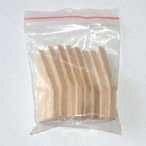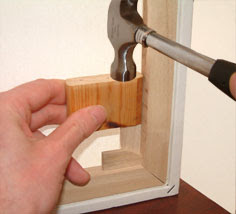Tips For Using Pre-stretched Canvas.
For those of you — like me — that prefer to purchase your canvas pre-stretched rather than stretching your own (and if you're like me, it's because you're lazy), here are a few tips for preparing a canvas for paint...
1) Fixing a loose or sagging canvas.
This is an issue I often run into purchasing pre-stretched canvas. The canvas isn't stretched as tight as I'd prefer, or it's downright loose and wavy. To correct this problem, there are a number of "tricks" from which I often achieve good results.
The simplest way to tighten a pre-stretched canvas is to shrink it. First I place the canvas on my easel with the back of the canvas facing me. I then use a spray bottle filled with warm water to evenly mist the back of the canvas. The key here is to only dampen the canvas, not soak it. Once I've finished misting, I immediately begin drying the canvas with a hair drier. When the canvas is dry, I check to see if it's as tight as I like and to make sure there are no longer any wrinkles or waves in the canvas. If there are, I repeat the process. You can also "spot-shrink" the canvas. If you find the canvas is overall as tight as you'd like, but there is a wave near a corner, you can mist only the wave or wrinkled area and dry with a hair drier.
 The next solution for tightening a loose canvas is to use canvas keys (or tightening keys). Have you ever wondered what those little wedges of wood or plastic are that came with your pre-stretched canvas? Well, now you know. Most manufactures of pre-stretched canvas do include canvas keys (especially with larger canvas).
The next solution for tightening a loose canvas is to use canvas keys (or tightening keys). Have you ever wondered what those little wedges of wood or plastic are that came with your pre-stretched canvas? Well, now you know. Most manufactures of pre-stretched canvas do include canvas keys (especially with larger canvas). To tighten the canvas, you simply insert a key into each slot located in the corners of the stretcher bars then lightly tap them into place until the canvas is taught. It doesn't take too much force, and you'll want to be careful not to split the wood of the stretcher bars. I've found canvas keys
To tighten the canvas, you simply insert a key into each slot located in the corners of the stretcher bars then lightly tap them into place until the canvas is taught. It doesn't take too much force, and you'll want to be careful not to split the wood of the stretcher bars. I've found canvas keysespecially useful for larger paintings that have been hanging for several years and have relaxed over time.
2) Toning a pre-stretched canvas
Toning a canvas is most often an artistic choice for the artist. Its main purpose is to provide an underlying color that helps unify the completed painting. But here I suggest toning for its practical benefits.
I typically tone my canvas using either a neutral color (like gray), or as is most often the case, a sepia tone (mixed using burnt sienna and ultramarine). I thin the mixture to an ink-like consistency. Liquin is the medium I use to thin the paint — and this is the key. Using Liquin (which is an alkyd resin) serves two main purposes, first it creates an extremely durable ground on which to apply your paint. And second, its slightly slick finish increases paint adherence giving your paint better covering power.
Unlike thinning paint using a solvent such as mineral spirits or turpentine (or any painting medium that includes a solvent), which serve to breakdown the paint's ability to bind with the surface, Liquin dramatically increases the paint's binding power.
Note: Although Liquin is a great choice for thinning paint for toning a canvas, increasing drying time or increasing paint flow, absolutely do not use it to varnish a painting. Using Liquin as a varnish may look great, but the purpose of varnish is to place a protective, REMOVABLE layer over the paint. Liquin is not removable and it doesn’t allow the paint to breath. There currently are no known solvents that can safely remove Liquin from a painting’s surface.
I hope you found my first ‘Tips’ entry useful.
Happy painting!

You are a very helpful artist type person. --Ray
ReplyDeleteWhat Ray said. :)
ReplyDeleteGreat blog, Dustin. I enjoy reading. Keep it up.
ReplyDeleteI stretch my own canvases so if things loosen up I usually just re-stretch altogether - but that can take some time and work.
I came across a solution at signaturecanvas.com that I thought I would pass on to you and your readers. They have a product called the Keyless Frame system. I haven't used it myself, but it looks like a great solution for keeping pre-stretched canvases tight - especially with linen. They are a great company to work with.
Good tips Dustan....I always knew those keys were for tightening the canvas, but could never figure out exactly how they worked. Doh! So thanks for that.
ReplyDeleteThanks for this tip,I really don't know what to do with those wedges,very useful tip and you have a beautiful blog...happy to follow you:)
ReplyDeleteAnu
Hi,
ReplyDeleteI still have to find out if those keys are inserted like that (as most people do) or forming a 45º angle.
José
I appreciate the tip...working on my canvas right now.
ReplyDeleteA wedge is a wedge. It shouldn't matter whether you insert them parallel to or diagonal to the stretcher bars. I use he water mist method and have never had to go to the wedges.
ReplyDelete